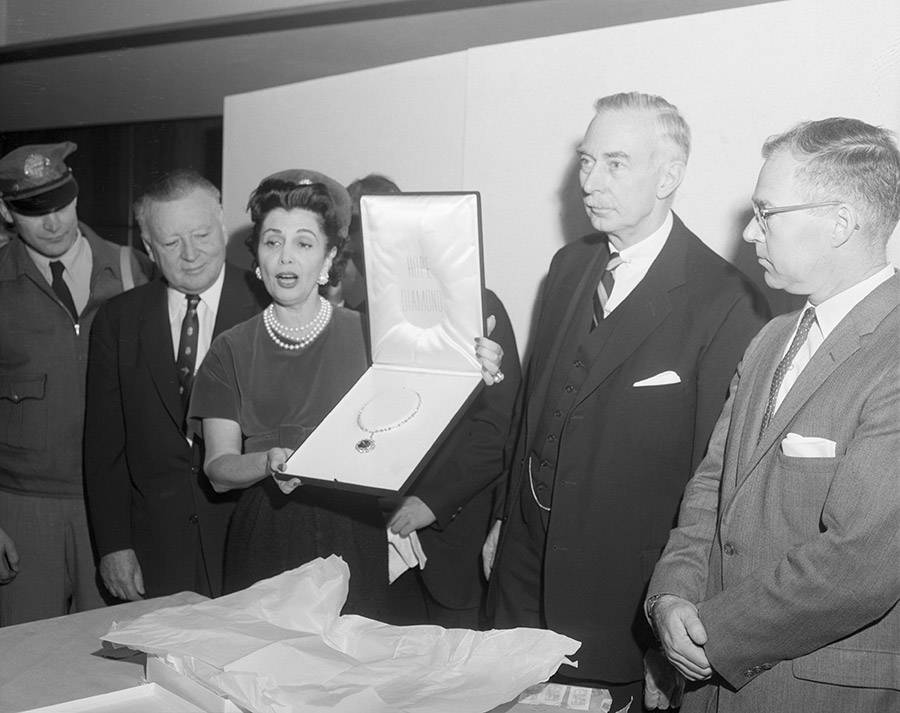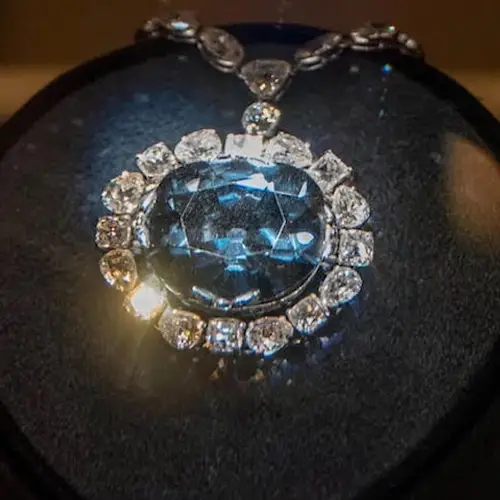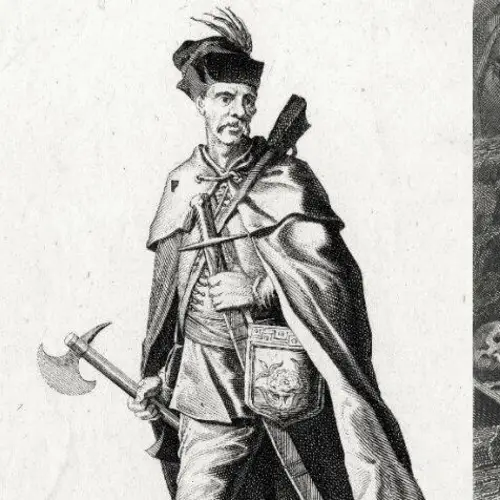Today, the 45-carat Hope Diamond sits safely in the Smithsonian's Museum of Natural History, but the brilliant blue gem has purportedly brought death and misfortune to dozens of people associated with it over the past 400 years.
Deep in the heart of the National Museum of Natural History in Washington D.C., there lies a diamond. It's a deep, inky blue color, but hit it with ultraviolet light and it emits an eerie red glow that lingers long after the light source has been switched off.
The diamond has gone by many names. Le Bleu de France, The Tavernier Blue, and Le Bijou du Roi. You probably know it as the Hope Diamond.
For centuries it has been one of the most famous diamonds in the world, at points belonging to some of the most influential monarchs in history and residing in some of the most important collections. As well known as the diamond is, the curse that follows it through history may be even more famous and has inspired countless books.
The Hope Diamond Curse Begins

Wikimedia CommonsThe Hope Diamond on display.
The Hope Diamond's bloody history begins many, many centuries ago.
Legend has it that the diamond once lay in the statue of the goddess Sita, wife of Rama, the 7th Avatar of Vishnu, serving as her eye. One day in 1666, a thief named Jean-Baptiste Tavernier gouged the diamond out, keeping it for himself. Supposedly, when religious leaders discovered this, they placed a curse on the diamond.
He took the blue diamond, alongside some others he had also likely stolen, back to France, where he sold them to King Louis XIV. The curse would allegedly catch up to Travernier. Some sources report the man was mauled to death by dogs in Constantinople, but that account may have just been a product of curse gossip.
Louis XIV had the gem cut by the court jeweler Jean Pitau. Around this time, the diamond began to be listed as the Blue Diamond of the Crown of France or the French blue.

Wikimedia CommonsKing Louis XIV had the diamond set in a cravat pin.
Louis XIV had a few misfortunes that have been attributed to the Hope Diamond curse. For example, all of his legitimate children apart from one died in childhood. He also died of gangrene after the diamond came into his possession.
The next victim of the rumored curse was the Superintendent of Finances in France from 1653 until 1661, Nicolas Fouquet. Fouquet served under Louis XIV's rule, and as the story goes, the king let the man wear the diamond on a special occasion.
Apparently, simply not owning the diamond doesn't mean you escape the curse. Not long after he wore the unique jewel, he was banned from the kingdom, later imprisoned for life in the Fortress of Pignerol.
The Hope Diamond Curse And The French Revolution

Wikimedia CommonsMarie-Antoinette was executed in 1793, and would frequently wear the French blue.
The next owner of the diamond was King Louis XVI of France. While it was his wife, Marie-Antoinette, that primarily wore the French blue, as we know, that's not enough to avoid the curse's wrath.
Famously, the rule of King Louis XVI and Marie-Antoinette did not end well. Both were executed during the French Revolution in the 1790s.
The curse also spread to Marie-Antoinette's lady in waiting, Marie Louise, Princess de Lamballe. Maire Louise would also occasionally wear the French blue, and much like many other members of the royal family and aristocracy, she was killed during the revolution.
While Louis, Marie-Antoinette, and Marie Louise's fates have been attributed to the curse of the Hope Diamond, it's safe to say there were many factors that led to the French Revolution and the demise of the French royal family. However, their gruesome deaths definitely add to the mystique of the legend.
After the French Revolution, the diamond went MIA for a couple decades before appearing once again in London. This time, the curse befell Wilhelm Fals, the jeweler who cut the diamond yet again.
Fals is the man responsible for cutting the diamond into the iconic shape it's known for today. Around the same time, it also earned a new nickname after its new owner, Henry Philip Hope: the Hope Diamond.
It's unclear what exactly happened to Fals. Some sources claim he lived, but his son later committed suicide. Other sources claim that Fals' was killed by his son, before his son went on to take his own life. Regardless, Fals proved the curse was alive and well, even after the bloody French Revolution.
The Hope Curse In The 20th Century

Wikimedia CommonsThe Hope Diamond now sits in the National Museum of Natural History in Washington D.C.
The diamond continued to be owned by various individuals throughout the 19th century. However, the curse picked up again when the diamond changed hands multiple times in the early 1900s.
A New York Times article from 1911 listed the recent victims of the curse at the time, including a Russian prince named Ivan Kanitovski, who supposedly bought the diamond off of a man named Jacques Colet.
Supposedly after owning the diamond, Kanitovski was killed by Russian revolutionaries, likely during the 1905 revolution. The prince loaned the diamond to French actress Mademoiselle Ledeu, who also met a grisly fate. She was later murdered by her lover.
Sometime after Kanitovski owned the diamond, it fell into the hand of Simon Maoncharides, a Greek merchant. Maoncharides would eventually sell the diamond to a Turkish sultan, before perishing in a terrible car accident that killed him, his wife, and his child.
The Hope Diamond curse then spread to its next owner, Sultan Abdul Hamid II of Turkey. His reign, which was plagued with misfortune, rebellions, and unsuccessful wars, led him to be known as "Abdul the Damned." Maybe the diamond was to blame.
The diamond's next pair of owners are the last individuals to own the diamond before it was brought to the Smithsonian in the 1950s. Edward Beale McLean and his wife Evalyn Walsh McLean, owners of the Washington Post, bought the diamond in 1911 off of jewelry designer Pierre Cartier.
By this point, the curse was well-known. The deal to buy the diamond included a fatality clause, which stipulated that should any misfortune befall Edward, the diamond could be exchanged.
The couple's marriage ended in 1931, and Evalyn ended up with the diamond. Edward was declared legally insane only two years later and was committed indefinitely to a psychiatric hospital. Evalyn maintained she never believed in the curse.
After she died in 1947, the diamond ended up in the care of trustees until her grandchildren reached 25 years old. However, they eventually sold the diamond to settle some debt to merchant Harry Winston.
Not long afterwards, Winston agreed to donate the gem to the National Museum of Natural History. That's when the curse struck for the final time.
The Hope Diamond was sent to the museum via the USPS. The mail carrier who delivered the diamond, James Todd, was unfortunately the last chosen victim of the infamous curse.
As the story goes, shortly after making the successful delivery, Todd crashed his mail truck and shattered his leg. But the curse supposedly didn't stop there, he later got in another crash, injuring his head. To top it all off, Todd's house burned down.
Was it the curse? Or was it all a coincidence?
Now that you've read about the Hope Diamond curse, read about the unlucky people who fell victim of King Tut's Curse. Then, read about the Antwerp Diamond Heist, which resulted in the disappearance of $100 million dollars in merchandise.



















































